Recently identified, four CA natives on the property are ‘new to me.’ If you read this blog very much, you know that I’ve been compiling a sort of natural history of the California natives on the place.
After ten years here and five years since the house was built, I have thought I knew all the plants here. Not so. It’s a happy day when a new kind of plant is discovered, recognized and identified. I saved these up to tell about, all found this Spring, though.
Chaparral Honeysuckle, Lonicera interrupta
Found twisting up through Manzanita or oak trees, this honeysuckle, I believe this will bloom yellow and although I haven’t seen it bloom, I have mistaken it for poison oak, the type that twines up the trees and then discovered it was not, then have thought it was a weed. Basically, I ignored it. Recently seen on some blog or website, my attention has snapped into focus and I realize it a very useful CA native vine for the garden.
Chaparral Honeysuckle has round, opposing leaves with a delicate grey-green color. The leaves are the size of pennies. You can chop it to the ground, (thinking it is Poison oak) and it good-naturedly grows back thicker than before, with no offense taken. In April the vine sends tendrils up through the tree or bush closest. In May, start looking for the blooms. I may try to transplant one or two closer to the house so they can be enjoyed.
Pacific Woodrush, Luzula comosa
This delicate grassy rush grows in the shade of an oak and I’ve just this year distinguished it from the various grasses. It grows in wetter areas of the ground, either in clay or sandy soil, often under Interior Live Oak, Quercus wislizenii, with poison-oak often present. The grass-like leaf parts are about 3-4 inches high and have reddish tips. On the top 2 inches of each slender round, green stalk are groups of spiky reddish bristles about 1/4 inch long. These bristles hold the seeds. Without competition from weeds it can grow to 18′” tall.
Here in this garden, there is a grouping of the sedge, spaced evenly about 8-10 inches away from each other, under an oak, with California Golden violets as their companions. Both bloom in early March and together, are attractive when the area is kept free of larger weeds, due to the uniformity of their spacing.
Unknown Penstemon
There is a 15 foot wide airy colony of this by the mailbox up at the top of the circle and one slender plant down in the lower 40. I was pleased to see it appear here as I haven’t found any existing penstemon. I seem to remember that it’s pale yellow or white, but it is yet to bloom. The stems are bright green and smooth. The leaves are slender, opposing and about and inch and a half long.
April 2015 Update:
Identified as Bush Beardtongue, Keckiella breviflora. See it in bloom here. Summer native discoveries
True babystars, Linanthus bicolor
I have searched and searched to find an ID for this one, finally posting a photo to Dave’s Garden Plant Identification forum. They usually have the answer in one day, as it was in this case. The plant looks like moss, stickery-looking, but soft puffs of foliage with tiny hot pink star-shaped flowers, one to a puff. It lies flat to the ground and forms a neat 6-8 inch mat in between the wildflowers in the meadow and surrounding areas whether in sun or shade. I am relieved that it is native because it covers the banks near the new meadow.
My idea of gardening is to discover something wild in my wood and weed around it with the utmost care until it has a chance to grow and spread.
– Margaret Bourke-White
These are the plants blooming around May 1st
 This particular variety of owl’s clover is called Valley Tassels, Castilleja lineariloba, and grows everywhere in the fields here. This rare variety has rosy tips of the ‘petals’ near the top; most have white bracts. Click the photo to see all the detail in this interesting flower.
This particular variety of owl’s clover is called Valley Tassels, Castilleja lineariloba, and grows everywhere in the fields here. This rare variety has rosy tips of the ‘petals’ near the top; most have white bracts. Click the photo to see all the detail in this interesting flower.
At the top of our street near the road is a large colony of it, growing along with Miniature lupine, Lupinus bicolor, Rose Clover, Trifolium hirtum and filaree (my nemesis!).
This ‘Ray Hartman’ Ceanothus was planted in 2006 and has grown larger than planned! In full bloom now it now divides the Salvia Garden from the wilder area below, where I just planted the ‘wildflower seedlings or ‘muffins‘.
The bees, carpenter bees and syrphid flies all love this ceanothus, a much showier cultivar than the native ceanothus,
Ceanothus cunneatus or Buckbrush. If you click on this one, just below, you’ll see the bee. 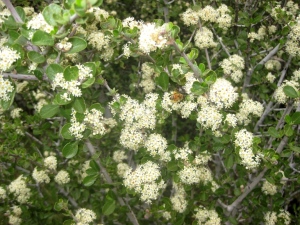
This buckbrush is all over and I have trimmed it, informally, like hedges in one case, beyond the wild meadow in kind of a wave shape.  Up on the hill above the house I have trimmed some just to neaten them. Soon they will be too tall. These, above, are about to bloom in this photo taken about a month ago. Buckbrush can cover entire hillsides here and must reseed easily because I see it and encourage it to grow in some of my planting areas. It’s easy to shape and makes a good foundation or background for other plants in the garden.
Up on the hill above the house I have trimmed some just to neaten them. Soon they will be too tall. These, above, are about to bloom in this photo taken about a month ago. Buckbrush can cover entire hillsides here and must reseed easily because I see it and encourage it to grow in some of my planting areas. It’s easy to shape and makes a good foundation or background for other plants in the garden.
 The California poppies are blooming and in the new meadow they are spectacular along with all the other color there.
The California poppies are blooming and in the new meadow they are spectacular along with all the other color there.  The Blue Flax, Linum lewisii is blooming in the entry garden and on the south sid of the house. These grow like perennials and I leave the foliage on over the winter and trim them just before they start to bloom. Lovely plant!
The Blue Flax, Linum lewisii is blooming in the entry garden and on the south sid of the house. These grow like perennials and I leave the foliage on over the winter and trim them just before they start to bloom. Lovely plant!
 This is my favorite photo of the flax flower taken a couple years ago. The flowers close up at night and seem to like partial shade. There are many seedlings coming up in the new native meadow, so it will be interesting to see if they are sufficiently shaded by the grasses, to survive in full sun.
This is my favorite photo of the flax flower taken a couple years ago. The flowers close up at night and seem to like partial shade. There are many seedlings coming up in the new native meadow, so it will be interesting to see if they are sufficiently shaded by the grasses, to survive in full sun.
I like this Rose Clover, even though it’s not a native. It’s everywhere and must like the conditions here. There is a fine field of it on the banks along the driveway, but I ‘weed’ it out of planting beds because they can take over.
Bear Clover, Chamaebatia foliolosa, is a native groundcover shrub, in groups, or colonies, it carpets the roadsides heading into Yosemite. There is a large showing here on the place in a swale where we ultimately put our well. It likes wetter areas , so apparently the well guys knew there was water there. It’s growing back there nicely there, through underground roots and I encourage it everywhere I see it in the garden areas,growing solidly in nice patches, mostly near the oaks, giving it a little water when I hand water things. The blooms will remind you of strawberry flowers, but it’s in the Rose family.
 The Bee’s Bliss sage, a combination of Salvia clevelandii and Salvia sonomensis, is blooming now, but this photo was taken a week or so ago, when the Creeping Phlox was in full bloom.
The Bee’s Bliss sage, a combination of Salvia clevelandii and Salvia sonomensis, is blooming now, but this photo was taken a week or so ago, when the Creeping Phlox was in full bloom.
As for the rest of the garden the Iris, Ajuga, Lavender, Wallflower and Snow in summer are all blooming in beds near the house.
I should say that all these are deer-resistant, I’d say deer proof in my area. We have no deer fencing and although I hear from my gardening friends that they “can’t grow anything because of the deer,” it certainly isn’t true. How resistant to deer a plant is ha driven the selection of plants in my garden and much study and observation was done to see what they would eat here. It’s gratifying, no end, to see the lovely deer turn up their noses and pass on sampling my beloved plants. You can have a colorful garden and welcome deer into it as well.
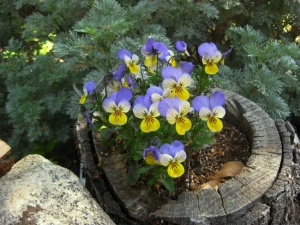 Wishing you all a nice Mother’s Day!
Wishing you all a nice Mother’s Day!
I’ll be working on projects, weeding the garden, adding to the CA Native seedling page and putting together a post on progress of the new native meadow. Wait ’til you all see it!
Sue
Thanks to Mark Egger, an expert in Castilleja for positively identying this Owl’s Clover from what I first had C. attenuata to C. lineariloba, whose name I got from Katie at NatureID.

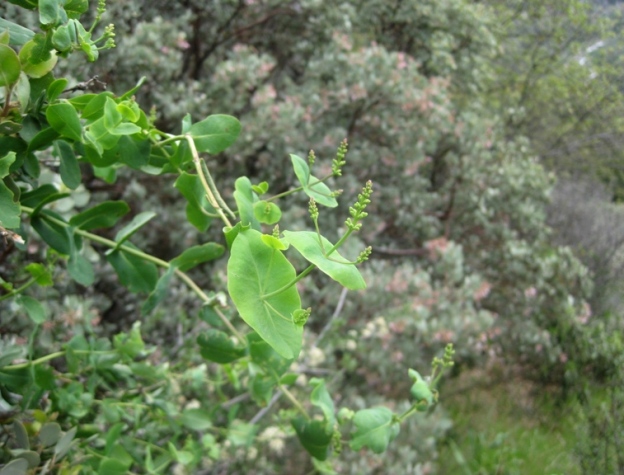

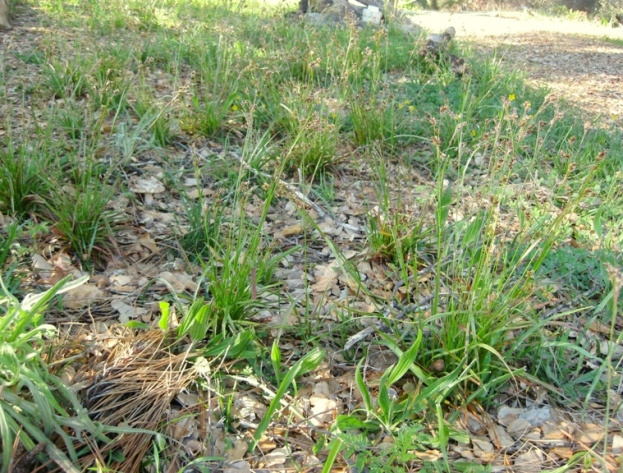
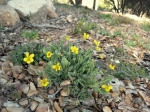
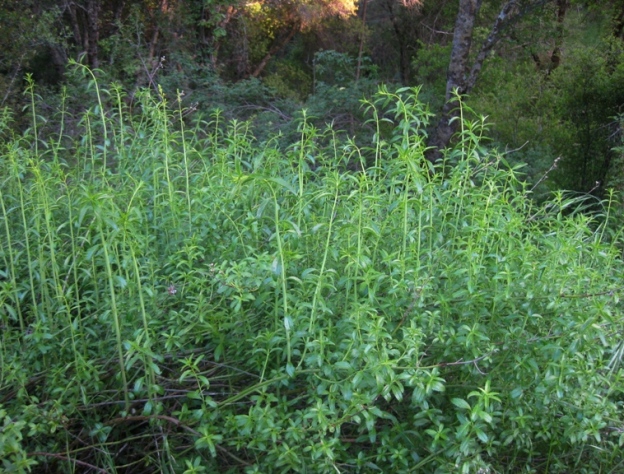

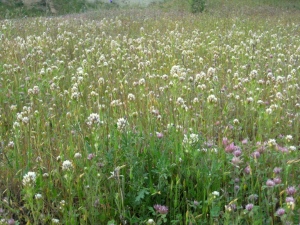
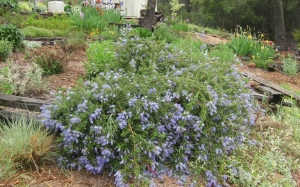




8 comments